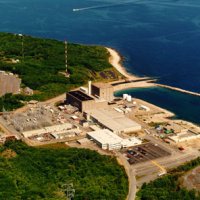Pilgrim Nuclear Power Station (PNPS) is the only operating nuclear power plant in the U.S. state of Massachusetts – and it won’t be operating for much longer.
After having spent hundreds of millions of dollars to improve reliability, safety and security of the Pilgrim Nuclear Power Station, Entergy has announced it would be closing the facility no later than June 2019.
Entergy says the decision was made due to poor market conditions, reduced revenues and increased operational costs. The company states current and forecast power prices have fallen about USD $10 per megawatt hour, meaning an annual loss of more than $40 million in revenues for Pilgrim.
Pilgrim Nuclear Power Station has a 690 MW production capacity and contributes approximately 14% of the electricity generated in Massachusetts.
After shutdown, Pilgrim will transition to decommissioning – another expensive process. The plant site also hosts a dangerous legacy; spent nuclear fuel in an on-site storage pool that is awaiting federal direction on the correct disposal process.
So what will take Pilgrim’s place? While gas fired power generation is a very likely winner; solar and wind power may get more of a look in. With energy storage rapidly evolving, renewables may play a bigger role in the state’s energy mix than previously contemplated.
Massachusetts appears to be a renewable energy friendly state.
Massachusetts’ Renewable Energy Portfolio Standard (RPS) was one of the first programs in the USA requiring a certain percentage of the state’s electricity to come from renewable energy.
A goal to achieve 250 megawatts of solar power installations set by the state was achieved four years early; so an aggressive new goal was set of 1,600 MW by 2020. With regard to wind power, Massachusetts’ goal is to install 2000 megawatts of wind energy by 2020.
The state is also is also interested in energy storage. Massachusetts’ $10 million Energy Storage Initiative (ESI) is designed to advance this particular segment of the state’s clean energy industry.
Nuclear power has been losing support in the USA for some time and the business case for it is looking increasingly weaker. Bloomberg New Energy Finance (BNEF) recently stated the levelised cost of electricity of nuclear-power in the Americas and Europe rose to $261 per megawatt-hour in the second half of this year.
According to the Nuclear Energy Institute, 30 countries are operating 438 nuclear reactors for electricity generation (as at July 2015) and 67 new nuclear plants are under construction in 15 countries.
















































